DICHROIC JEWELRY |
|
|
| |
STAINED GLASS |
| |
RELATED LINKS |
|

Ymir
Many people have asked
us where the name Ymir comes from. Ymir is a an important
figure in Norse Mythology. The giant Ymir
was killed by Odin and his brothers and from the
slain body heaven and earth was created.
One might say that Ymir became the source of a lot
of creativety.

|
|
More information about art glass and fusing techniques
for our Scandinavian visitors
Glass
Forum
|
|
|
Ymir Glass Design
is a small glass studio, situated in Bangor Maine. They specialize
in fused dichroic glass jewelry, stained glass panels and
three dimensional glass objects.
The work shown here is made by Bob Harris and Anne Reigstad.
Before they started their glass business, Bob was a machine
mechanic at Osram Sylvania in Bangor, while Anne for many
years worked as a journalist in her home country Norway.
Working with glass started as a hobby, which has now developed
into a growing business. |
 |
Space Age Glass
Our jewelry is made from several layers of dichroic glass
and art glass fused together in a kiln at near 1500 degree
F - often fired several times to get the desired effect.
Dichroic glass has become popular among glass artists and
jewelry makers because of its vibrant colors and intriguing
shine.
Because dichroic glass is a spinoff from the space industry,
it is often referred to as "space age glass". The
dichroic coating was originally developed by NASA and used
in satellite mirrors.
Because of the coatings' ability to reflect almost all light
energy, we can find it in Halogen lights, infrared lasers
and movie making equipment.
Dichroic glass is now made commerceally for the glass art
community. Actually, the term dichroic glass is incorrect.
Dichroic is a coating so thin that it has to adhere to something,
and glass is an ideal medium.
Many molecular thin layers of melted quartz crystal and metal
oxides are deposited onto the glass in a vacuum chamber.
It's a complicated process that makes this glass among the
most expensive in the world.
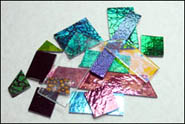
Dichroic glass comes in a large variety of colors,
patterns and textures.
|
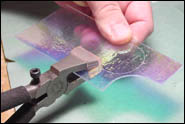
The glass is cut and arranged into different designs.
|
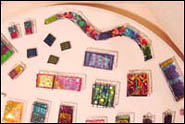
Finished jewelry pieces are placed in the kiln
for fusing. |
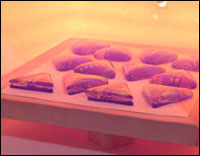
The kiln has to be heated up to about 1500 F for
the glass to melt.
|
|
|
It's all about light
What we experience as color is the frequency - or wavelength
- of light that is reflected back to us from the object we
are looking at. The color we see is dependent on how much
of the light is absorbed by the object, and how much is reflected.
If less then 1 % of the light is reflected, the object is
black. If more then 90 % of the light is reflected, the object
is white.
What's so intriguing about the dichroic coating is that all
light energy is either reflected or transmitted. The coating
itself is colorless.
So, why does jewelry made from dichroic glass have such vibrant,
bright, sparkling colors?
The coating forms a crystal structure comprised of many layers,
and the layers reflect different wavelengths of light. In
other words; it's the thickness of the coating that determines
what color we experience.
More technically; - the layers produce an interference filter.
This interference effect can also be seen in nature, in a
dragonfly wing or a bird feather.
|
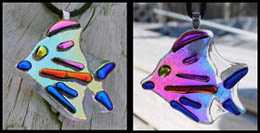
Dichroic is a Greek word and it means "two
colors." Dichroic glass transmits one color (the
pendant on the right), and reflects another color (the
pendant on the left).
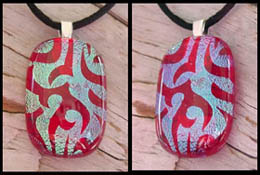
In adition, a third color can be seen when you view
the dichroic glass from an angle. |
|
|